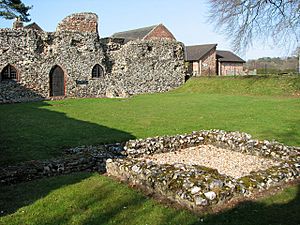Henry Jerningham facts for kids
Quick facts for kids Sir Henry Jerningham |
|
|---|---|
| Spouse(s) | Frances Baynham |
| Issue | |
| Henry Jerningham William Jerningham Francis Jerningham Mary Jerningham Jeronyma Jerningham |
|
| Father | Edward Jerningham |
| Mother | Mary Scrope |
| Born | 1509/10 |
| Died | 6 September 1572 Costessey, Norfolk, England |
Sir Henry Jerningham (born around 1509 or 1510 – died 6 September 1572) was an important English courtier during the time of the Tudor kings and queens. He served King Henry VIII as a special guard called a Gentleman Pensioner.
When King Edward VI died in 1553, there was a big question about who would be the next ruler. Henry Jerningham was one of the strongest supporters of Mary Tudor, who later became Queen Mary I. After she became queen, he was one of her most trusted helpers. He was given important jobs like Vice-Chamberlain of the Household, which meant he helped manage the Queen's home. He also became the Captain of the Yeomen of the Guard, leading the Queen's personal guards. Plus, he was part of the Privy Council, a group of close advisors to the monarch.
Sir Henry's Family Life
Henry Jerningham was the son of Edward Jerningham, who lived in a place called Somerleyton in Suffolk. His mother was Mary Scrope. Henry's mother, Mary, had nine sisters. Through his mother's family, Henry was related to some very important people. For example, his aunt Elizabeth Scrope married John de Vere, 13th Earl of Oxford, a powerful nobleman.
Henry had three brothers and one sister from his mother's first marriage:
- Ferdinand Jerningham
- Edmund Jerningham, who was a special attendant to King Henry VIII
- Edward Jerningham
- Elizabeth Jerningham, who worked as a Maid of Honour for Queen Mary I.
Henry's father, Edward, had also been married before. So, Henry had several half-brothers and half-sisters, including Sir John Jerningham.
Henry's father passed away in 1515. Later, his mother married Sir William Kingston. Sir William was a very important person himself. He was in charge of the Tower of London, a famous castle and prison.
Sir Henry's Career and Service
In 1528, Henry Jerningham began studying law at the Inner Temple in London. Around the same time, he started working for Mary Tudor, who was then King Henry VIII's elder daughter.
Around 1540, he became one of King Henry VIII's Gentlemen Pensioners. These were a group of armed guards who attended the King on important occasions. Henry was present at many big state events. In 1544, he even joined the King's army in France, bringing five of his own horsemen. That same year, he and his wife were given a manor (a large estate) in Suffolk. In 1546, he received the land where the old St Olave's Priory used to be.
Not much is known about what he did during the short reign of King Edward VI. However, when King Edward died in 1553, there was a struggle for the throne. John Dudley, 1st Duke of Northumberland, tried to make Lady Jane Grey queen. But Henry Jerningham was one of the first to join Mary Tudor at Kenninghall to support her claim to the throne. He even gathered troops in Suffolk to fight for Mary.
When Mary became Queen, she rewarded him greatly. She made him Vice-Chamberlain of the Household, meaning he helped manage the royal household. He also became Captain of the Guard, leading the Queen's personal bodyguards. At Mary's coronation, he was made a Knight of the Bath, a special honor. Soon after, he joined the Privy Council, a group of the Queen's closest advisors. His wife, Frances, also became one of the Queen's gentlewomen. Henry received more rewards, including large areas of land. One of these was the manor of Costessey in Norfolk, where he rebuilt a grand house called Costessey Hall.
Henry Jerningham played a key role in stopping Wyatt's rebellion in 1554. This showed that he was truly one of Queen Mary's most trusted servants. In 1557, he became Master of the Horse, a very important position that involved managing the Queen's horses and stables. He also received a large yearly payment for this job.
Throughout Queen Mary's reign, he served as a Knight of the Shire, which meant he was a representative in Parliament for different areas. He represented Suffolk four times and Gloucestershire once.
Queen Mary chose Henry Jerningham as one of six people to help carry out her will after she died. However, when Queen Elizabeth I became queen, she removed him from his official positions. He then retired to his home at Costessey Hall. He made his will on 15 August 1572 and passed away on 6 September that same year, at about 63 years old. He was buried in the church at Costessey. His wife, Frances, and two of his sons, Henry and William, and one daughter, Jeronyma, outlived him.
Marriage and Children
Henry Jerningham's marriage was arranged by his stepfather, Sir William Kingston. In 1536, Henry married Frances Baynham. She was the daughter of Sir George Baynham. Henry and Frances had three sons and two daughters:
- Henry Jerningham
- William Jerningham
- Francis Jerningham
- Mary Jerningham, who married Sir Thomas Southwell
- Jeronyma Jerningham, who married Charles Waldegrave.


